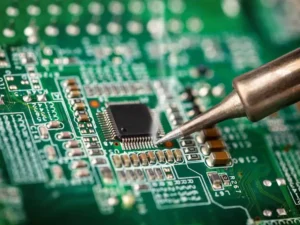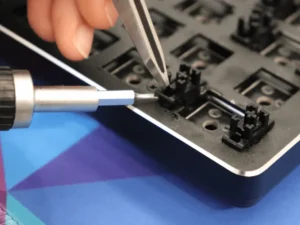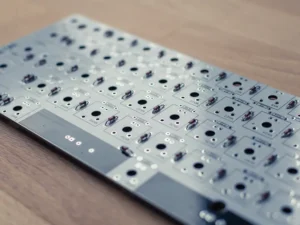A keyboard is an essential component of any computer setup. Understanding its technology can crucially impact your general computing experience.
The heart of any keyboard is its Printed Circuit Board (PCB), which serves as the backbone of the device.
This blog post will explore the world of Keyboard PCBs. It will provide you with everything you need to know about this crucial component.
What is Keyboard PCB?

A Printed Circuit Board (PCB) is the primary circuit board used in a computer keyboard. It is to control the electrical signals produced by pressing keys.
It contains the microcontroller, diodes, resistors, capacitors, and switch contacts that make up the electronic components of a keyboard.
The PCB for keyboard connects all these components, providing electrical pathways between them. It acts as the foundation for the keyboard’s functionality.
The microcontroller on the PCB processes signals from the key switches. It also communicates with the computer and manages other functions, such as macro programming, lighting control, and media keys.
The PCB also includes diodes for each switch. They protect against ghosting by allowing current to flow in only one direction.
Note: Ghosting is a phenomenon where many keys register as pressed when only one key is pressed)
The PCB also provides the mounting points for the switches, stabilizers, and other components. Its design can affect the feel and performance of the keyboard.
The keyboard PCB design and type affect the feel and performance of the keyboard. It can vary between different keyboard models.
Types of Keyboard PCBs:
The main types of keyboard Printed Circuit Boards (PCBs) are:
1. Hot-swappable PCBs:
They are easily removable and replaceable, without the need for soldering or other special tools.
This allows users to conveniently swap out key components of their keyboard without needing technical expertise or specialized equipment.
Hot-swappable PCBs are particularly popular among mechanical keyboard enthusiasts looking for greater customisation and flexibility.
2. Soldering PCBs:
They require soldering to install and secure the components on the board.
Unlike hot-swappable PCBs, soldering PCBs cannot be easily removed or replaced once installed.
This means that only skilled users with specialised equipment can make changes to the components on their keyboard.
Soldering PCBs are generally used in more permanent, or high-end keyboard builds.
This is because soldered connections are more secure. They are also less likely to come loose than connections made with other methods.
PCB Keyboard Mounting Styles:
1. Plate mounted:
It is a PCB mounting style commonly used in mechanical keyboards. The PCB is mounted inside a metal or plastic plate, which is the foundation for the key switches. The key switches are then mounted to the plate, and the whole assembly is mounted to the keyboard case.
2. PCB mounted
They are also known as surface mounted PCBs. In this style, the key switches are soldered directly to the PCB. This eliminates the need for a separate metal or plastic plate as in the plate-mounted style.
This can result in a slimmer, more compact design and lower production costs. But, it may also make the keyboard less stable.
Components of a Keyboard PCB
The following are the main components found on a Keyboard Printed Circuit Board (PCB):
- 1)Microcontroller:This is the central processing unit of the keyboard. It manages the communication between the keyboard and the computer. It processes signals from the key switches, and sends keystrokes to the computer. It can also handle extra functions such as macro programming, lighting control, and media keys.
- 2)Diodes:These are a electronic components that prevent “ghosting” by allowing current to flow in only one direction.
- 2)Resistors:These are passive electronic components that resist the flow of electrical current. It can be used to control the strength of signals, regulate power, and protect other mechanical keyboard PCB’s components.
- 3)Capacitors:These are passive electronic components that store electrical energy. It can be used to filter signals, and stabilize the power supply. It can also provide temporary power to components during power fluctuations.
- 4)LEDs:These are light-emitting diodes that can be used for lighting, status indicators, and backlighting for the keys.
- 5)USB Connector:This is the port to connect the keyboard to the computer via a USB cable.
- 6)Other Components:Other components that may be found on a keyboard PCB include:
- a. Oscillators;
- b. Transistors;
- c. Switch matrix;
- d. Controllers;
- e. Other passive and active electronic components.
These components work together to provide the functionality of the keyboard.
Choosing the Right Keyboard PCB:
Choosing the right PCB is essential for ensuring that the keyboard meets the user’s needs. It provides the desired level of performance and functionality.
The following are the key factors to consider when selecting a keyboard PCB:
- 1)Compatibility:The keyboard should have the correct interface and protocols to ensure seamless communication with the computer. It must be compatible with the desired operating system (such as Windows, MacOS, or Linux).
- 2)Features:It can significantly impact the user experience and level of functionality. Features to ponder include USB type (such as USB 2.0, USB 3.0, or USB-C), programmability (the ability to program macros, media keys, etc.), RGB lighting, and other features that may be important to the user.
- 3)Brand and Price:Some brands have a reputation for producing high-quality, reliable, and well-supported keyboards. While others may be more focused on budget-friendly options. The price of the keyboard PCB can also affect the overall cost of the keyboard, as well as the quality and features of the keyboard.
- 4)User Reviews and Feedback:Reviews from other users can provide valuable insights into the keyboard’s performance, reliability, and overall user experience. They help users make informed decisions about which keyboard PCB to choose.
Conclusion
A keyboard PCB is a critical component in the design and function of a keyboard.
Understanding the main types of keyboard PCBs, the components involved, and the design and manufacturing process is essential for selecting the right keyboard PCB.
You must ponder factors such as compatibility, features, brand and price, and user reviews and feedback when choosing a mechanical keyboard PCB.
With this information, users can make informed decisions about which keyboard PCB best suits their needs. They can ensure they have a high-quality, reliable, and functional custom keyboard.
Whether you are a gamer, office worker, or simply someone who loves the best PCB keyboard, understanding keyboard PCBs is crucial in making the right choice.


